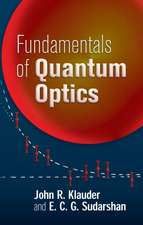Self-Organized Lightwave Networks: Self-Aligned Coupling Optical Waveguides
Autor Tetsuzo Yoshimuraen Limba Engleză Paperback – 3 apr 2018
1) Optical solder: Self-aligned optical couplings between misaligned devices with different core sizes
2) Three-dimensional optical wiring
3) Targeting lightwaves onto specific objects
SOLNETs are expected to reduce the efforts to implement lightwaves into electronic systems and allow us to create new architectures, thus reducing costs and energy dissipation and improving overall system performance. SOLNETs are also expected to be applied to a wide range of fields where lightwaves are utilized, for example, solar energy conversion systems and biomedical technologies, especially photo-assisted cancer therapies. Readers will systematically learn concepts and features of SOLNETs, SOLNET performance predicted by computer simulations, experimental demonstrations for the proof of concepts, and expected applications. They will also be prepared for future challenges of the applications. This book is intended to be read by scientists, engineers, and graduate students who study advanced optoelectronic systems such as optical interconnects within computers and optical networking systems, and those who produce new ideas or strategies on lightwave-related subjects.
Preț: 553.50 lei
Preț vechi: 651.17 lei
-15% Nou
Puncte Express: 830
Preț estimativ în valută:
105.91€ • 110.59$ • 87.46£
105.91€ • 110.59$ • 87.46£
Carte tipărită la comandă
Livrare economică 15-29 aprilie
Preluare comenzi: 021 569.72.76
Specificații
ISBN-13: 9781138746886
ISBN-10: 1138746886
Pagini: 224
Ilustrații: 166
Dimensiuni: 156 x 234 x 12 mm
Greutate: 0.36 kg
Ediția:1
Editura: CRC Press
Colecția CRC Press
ISBN-10: 1138746886
Pagini: 224
Ilustrații: 166
Dimensiuni: 156 x 234 x 12 mm
Greutate: 0.36 kg
Ediția:1
Editura: CRC Press
Colecția CRC Press
Cuprins
1. Introduction. 2. Related Technologies. 2.1 Self-Focusing of Lightwaves in Nonlinear Optical Media. 2.2 Photosensitive Materials. Photopolymers, Photosensitive glass, Photorefractive crystals. Self-Written Waveguides. 3. Self-Organized Optical Waveguides--- Self-Organized Lightwave Network (SOLNET). 3.1 Concept. Two-Beam-Writing SOLNET (TB-SOLNET), Reflective SOLNET (R-SOLNET), Luminescence-Writing SOLNET (L-SOLNET), Phosphor SOLNET (P-SOLNET), SOLNETs utilizing One-Photon and Two-Photon photochemistry. 3.2 Features Self-aligned optical coupling, 3-D optical wiring, Targeting lightwaves onto specific objects. 4. Proof of Concept by Computer Simulations. 4.1 TB-SOLNET/P-SOLNET. 4.2 R-SOLNET. 4.3 L-SOLNET. 4.4 SOLNET between Microscale and Nanoscale Waveguides. 4.5 Parallel and Branching SOLNET. 4.6 Vertical SOLNET for Optical Z-Connections. 5. Experimental Demonstrations 5.1 TB-SOLNET. Fiber and Fiber. 5.2 R-SOLNET. Fiber and Mirror, Fiber and Luminescent target. 5.3 SOLNET between Microscale and Nanoscale Waveguides. Fiber and LD. 5.4 Branching SOLNET. Fiber and Two luminescent targets. 5.5 Vertical SOLNET. Mask window and Mirror, From 45o mirror in waveguide film. 6. Expected Applications. 6.1 Optical Solder. Self-aligned optical coupling. 6.2 Integrated Optical Interconnects. Self-aligned optical coupling/3-D optical wiring. 6.3 3-D Micro Optical Switching Systems. Self-aligned optical coupling/3-D optical wiring. 6.4 Solar Energy Conversion Systems. Self-aligned optical coupling/3-D optical wiring. 6.5 Cancer therapy. Targeting lightwaves onto specific objects. 7. Future Challenges. Re-writable photosensitive materials for dynamic SOLNET. High-Rn photosensitive materials for high-index-contrast SOLNET. Control of gamma characteristics of photosensitive materials for optimized SOLNET. Interference pattern with SOLNET. 8. Summary. Appendix: Methods for Computer Simulations of SOLNET. Beam propagation method, Finite difference time domain method
Recenzii
"This book encapsulates how self-focusing photo-sensitive media can be utilized to enable the automatic formation of self-aligned coupling optical waveguides. Such self-organized lightwave networks (SOLNETs) are offered as a low-cost, low-energy means to introduce lightguides into electronic systems."
--K. Alan Shore, Bangor University, U.K.
--K. Alan Shore, Bangor University, U.K.
Descriere
The SOLNET (self-organized lightwave network) enables self-aligned optical coupling between misaligned optical devices with different core sizes, optical wiring in 3-D free spaces, and targeting lightwaves onto specific objects. These features make fabrication processes of optical networks within systems simpler to reduce the system cost. By reading this book, the readers can learn SOLNETs, their applications, and future challenges systematically. The readers can get hints to reduce the system cost by implementing optical solder and 3-D optical wiring of SOLNET into the systems.






















